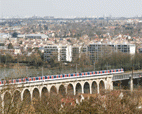
Four Departments under scrutiny
A study has been made in the context of a partnership between the General Councils of Hauts-de Seine, Seine-Saint-Denis and Val-de-Marne and the l’Insee Ile-de-France. It examines the territory covered by the 20 Parisian districts and the 123 municipalities of the Seine-Saint-Denis, Val-de-Marne and Haut-de-Seine Departments.
The first part of the study forms an overall view of residential mobility in the centre of the conurbation and shows that its frequency increased during the period 2002-2007. The second part analyses more precisely the amplitude of migration in different municipalities, the characteristics of newcomers and the impact of their arrival on the socio-professional structure of the territories.
The typology of the urban fabric determines residential mobility
Available housing in the existing stock accommodates most households in municipalities and districts (92%), after having been vacated by previous occupants, standing unoccupied or being renovated. Renewal of the population, due to mobility, mostly involves small housing units from the private rental stock where a large turnover of inhabitants is possible. In Paris and the bordering municipalities there is a lot of this type of housing and it is here that one sees the highest level of mobility with 30 to 40% of households residing for less than five years while the average rate in the four Departments is 28%.
In the more outlying municipalities where the urban morphology is of extensive residential patterns (Aulnay-sous-Bois, Marolles-en-Brie...) and/or the marked presence of social housing (Genevilliers, La Courneuve, Vitry-sur-Seine...) new arrivals count for only 10% to 20% of households. In these mainly residential municipalities which have affordable, suburban housing, families tend to move in on a long term basis and the turnover rate is low.
The building of housing is a strategy for accommodating more of the population. New housing has on the whole housed only 8% of new comers moving into the municipalities. However the building of housing has been relatively concentrated in municipalities undergoing reconstruction such as Saint-Denis, Courbevoie and Alforville which have benefited from an inflow of new arrivals.
*Therefore, depending on the typology of the urban fabric and the energy given to building, municipalities can have a high level of turnover of the population or on the contrary maintain the settled population over a long period, which leads to very different issues in terms of the facilities and services needed for the population.
A big impact on the sociology of territories
The social profiles of incoming households are never a true reflection of the local population, even if there are usually similarities. Managerial staff and highly qualified professionals prefer to integrate into municipalities and districts where their socio-professional category is already present in the west of the conurbation. Most office and blue collar workers move into municipalities which offer affordable residential areas and/or a large percentage of social housing.
Managerial staff are the most mobile socio-professional category. On the scale of the four Departments at the centre of the conurbation there is a higher average of managerial staff among incoming households than among the stable population, hence the impact of migration, on the whole, contributes to the gentrification of a territory.
In Paris and many municipalities in Haut-de-Seine (Puteaus, Issy-les-Moulineaux …) managerial staff and highly qualified professionals are already present locally, and are even more markedly present among incomers. This reflects both the higher qualifications required by job offers and the knock effect of rising property prices based on residential choices.
Another aspect of migration has been the increasing presence of managerial staff in certain bordering municipalities, although this category is, as yet, quite scantily represented (Saint-Ouen, Saint-denis, Montreuil, Ivry-sur-Seine, Gentilly...). Their presence has the effect of improving territories at an urban development level (quality of public spaces …) and public transport services, even though home prices remain very different from those in Paris.
Conversely migration does not contribute to an increase in the proportion of managerial staff in municipalities lying further north-east of Seine-Saint-Denis nor in certain municipalities south-east iof Val-de-Marne, which are still not very attractive to managerial staff in spite of the efforts made locally in terms of urban and economic development.
The diversity of the housing offer, the quality of urban development and public transport services therefore seem to be the leverage points for rendering territories attractive and maintaining a diversified population.
Part 1 of this study is also on line on the Insee Île-de-France website
